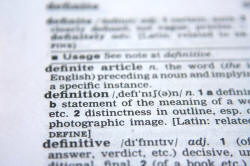Multi-word verbs: the essentials

Suggestion: If you are unsure about your ability to identify a preposition or an adverb, you should follow the guides to those two areas before you start.
This is an essential guide and will not cover the complications
of some multi-word verbs or what are called
phrasal-prepositional verbs but we will distinguish between a
phrasal verb and a prepositional verb because that is the essential
point to take away.
If you
want more, go to the more advanced guide
to multi-word verbs in the in-service section of the site which is
linked at the end.
 |
Definitions |
Multi-word verbs (hereafter MWVs) are verbs which consist of more
than one word. For example, we can say
I postponed the
meeting
or we can say
I put off the meeting
or
I
put the meeting off
with pretty much the same meaning.
The verb, in this case, is not just put – it is
put off.
In this guide, words like off, on, about etc. will often be
referred to as particles but you should know that
there is a bit more to it than that.
See if you can identify the multi-word verbs in this paragraph:
| He got off the train walked over to the taxi rank. Getting into the first cab he found, he told the driver to take him to the hotel and to hurry up because he was already running late. The trip to the city centre took up less than twenty minutes and he was dropped off at his hotel before noon. He complained about the cost of the taxi but the driver simply handed over an official list of airport fares and pointed at it. He paid up and carried his luggage into reception. The receptionist looked up his name in the register, gave him his key and pointed out where the lifts were. He was delighted to find out that they had put him in a room with a view of the Acropolis but he only had time to look at it for a few minutes before he went down to the meeting. |
| Click here when you have done that. |
| He got off the train walked over to the taxi rank. Getting into the first cab he found, he told the driver to take him to the hotel and to hurry up because he was already running late. The trip to the city centre took up less than twenty minutes and he was dropped off at his hotel before noon. He complained about the cost of the taxi but the driver simply handed over an official list of airport fares and pointed at it. He paid up and carried his luggage into reception. The receptionist looked up his name in the register, gave him his key and pointed out where the lifts were. He was delighted to find out that they had put him in a room with a view of the Acropolis but he only had time to look at it for a few minutes before he went down to the meeting. |
That was not an easy task and you will be forgiven for not having the same answers. There are a number of possible reasons why your answers may differ.
- Why isn't walk over
in red?
Compare these two sentences:- He walked off his headache
- He walked through the park
*He walked over his headache
Only off will work.
In sentence b., we have a verb, walk, followed by a prepositional phrase through the park and we can change it in lots of ways but retain the meaning of walk:
He walked over the road
He walked across the park
He walked out of the meeting
etc.
This is the basic test of a multi-word verb: does the meaning change if we change the particle? - Why isn't Getting
into in red?
For the same reason. This is simply the verb get followed by a preposition, into. We can get, for example:
get over an obstacle
get out of a train
get between two people
and so on. It is the verb get in its meaning of move to a place or position.
Compare these two sentences:- I got over my headache
- I got over the river
I got by / across / between / into / out of my headache
etc. without changing the meaning of the verb.
In sentence b., we have a verb, get, followed by a prepositional phrase over the river and we can change the preposition to make new meanings but keep the meaning of get the same. We can have, e.g.:
I got across the river / into the river / out of the river
etc. and still get means the same thing. - Why isn't look at in red?
For the same reason again but you will often find the combination look at described as a multi-word verb or even as a phrasal verb. It is neither because all we have is the verb look (meaning use one's eyes) and the preposition at which signals the direction.
This also explains why got off, take to, pointed at, carried into and went down are all left in black. They are simply verbs followed by prepositions. - Why isn't running late in red?
It is a metaphorical meaning of run in the sense of make progress but that doesn't make it a MWV. Here, the word late is an adverb and it can be replaced by something like on time, early, quickly, onwards, behind etc. without changing the meaning of the verb run.
Website alert:
There are rather too many sites out here that cannot distinguish
between a real MWV and a simple verb followed by a preposition.
For example, one site describes walk into a trap as a
phrasal verb. It isn't. It isn't even a prepositional
verb. It is simply the verb walk followed by a
prepositional phrase (into a trap). It may be a
slightly metaphorical use of walk but that's another matter
altogether.
Another describes run after the bus as a phrasal verb.
No, it isn't. It's the use of a verb (run) with a
prepositional phrase (after the bus). We can change
after for any number of other words without changing the meaning of
run:
run behind the bus
run in front of the bus
run
alongside the bus
run past the bus
etc.
There are lots more examples of lousy analysis on the web in the
in-service guide to this area.
 |
Ordering the words |
There's something else to note here:
Try moving the word in black around
in these sentences and see what happens if you replace it with
it:
- He handed over the list.
- He found out my name.
- I got onto the train.
- She looked up the word.
Click here when you have tried that.
- He handed over the list.
- We can have:
He handed the list over.
He handed it over. - We can't have
*He handed over it.
- We can have:
- He found out my name.
- We can have
He found my name out.
He found it out. - We can't have
*He found out it.
- We can have
- I got onto the train.
- We can have
I got into it.
I got into the train. - We can't have
*I got it into
*I got the train into.
- We can have
- She looked up the word.
- We can have
She looked the word up.
She looked it up. - We can't have
*She looked up it.
- We can have
You will have noticed:
- With some of these verbs you must put it (or any other pronoun) between the verb and the particle. These verbs are hand over, find out and look up. They are all true MWVs.
- With a verb followed by a prepositional phrase the only possible word order is Subject (I) + Verb (got) + prepositional phrase (into the train / into it). The reason is that we are not dealing with a true MWV here.
 |
Separable and inseparable |
As you saw, some verbs are separable and some cannot be
separated. Here's a short list of verbs. By making a
sentence like the ones above in your head, you should be able to see
which ones are separable and which ones are inseparable.
Click on the table when you have identified the two sorts.

There are reasons for this.
- The verbs with are inseparable (on the left) are examples of
prepositional verbs and that means that the
verb governs the preposition which is allowed but all the
prepositions are just parts of prepositional phrases.
We can allow, therefore:
She called for the children
She called for them
but not:
*She called the children for
or
*She called them for
In other words, the only word order we allow is:
Verb + Preposition + Object (noun or pronoun) and the same restriction applies to all of the examples right down to the end where we get:
She cared for the children
She cared for them
but not
*She cared the children for
or
*She cared them for. - The verbs which are separable (on the right) are
phrasal verbs and the vast majority of them must be
separated if we use a pronoun and can be separated if we use a
noun. So we allow:
He added the figures up
He added them up
He added up the figures
but not:
*He added up them
The only word ordering we allow with these verbs is:
Verb + Adverb + Noun
or
Verb + Noun + Adverb
or
Verb + Pronoun + Adverb
If you work down the list on the right, you will find the same restrictions apply to all of them until you get to:
He wore his pajamas out
he wore them out
He wore out his pajamas
but not:
*He wore out them.
The distinction is that
- a phrasal verb is a combination of a Verb and an Adverb
- other multi-word verbs are combinations of Verb + Prepositional phrase.
 |
With and without an object |
Some MWVs never take an object, some always do and some can do both. For example:
- She pulled off the trick.
A Phrasal Verb which must have an object and is (of course) separable.- We can have
She pulled off the trick
She pulled the trick off
She pulled it off - We can't have
*She pulled off it
*She pulled off.
- We can have
- It amounted to €300.
A Prepositional Verb which must have an object (a complement is a better term, but no matter) and is (of course) inseparable.- We can have
It amounted to €300 - We can't have
*It amounted €300 to
*It amounted
- We can have
- He complained about the service.
A Prepositional Verb which may or may not have an object complement and the preposition, of course, is only present when there is some kind of object.
- We can have
He complained about the service.
He complained about it.
He complained. - We can't have
*He complained the service about.
*He complained it about.
- We can have
- The headache wore off.
A Phrasal Verb which cannot have an object and is therefore inseparable (because there is nothing to separate!).- We can have
The headache wore off. - We can't have
*The headache wore off her.
- We can have
 |
Verbs with adverbs |
| He walked away |
One of the problems faced by both teachers and learners of
English is that there is a good deal of confusion about what is and
is not a phrasal verb.
We saw above that a phrasal verb is a verb whose meaning is combined
with an adverb to make a new meaning so, for example, if we add and
adverb particle to the verb look as in changing:
She looked in the dictionary
in which verb look simply means use your eyes to
She looked up the word in the dictionary
we can see that look plus up makes a new
meaning: find in a reference book.
Some people find this hard to grasp and insist that
any verb which is followed by an adverb must be a
phrasal verb. That way madness lies because we can have, for
example:
He walked away
He walked out
He walked back
He walked alone
He walked home
He walked quickly
and in all these cases the meaning of the verb does not
change.
It is not
true, therefore, that walk away, walk back or any of the
examples is a phrasal verb. They are cases of verbs being
modified by one-word adverbs, changing how we see the verb but
the verb retains its meaning.
Unfortunately, if you look out here on the web for examples of
phrasal verbs, you will find lots of people posting nonsense and the
most common piece of that is that something like:
She'll call back
I want to look around
They ran out
and many more contain examples of phrasal verbs. They do
not.
You may think this is just a minor problem because lots of people can't do very good language analysis and that's true but bad analysis like this has implications for learners which are not good.
- It means that learners are misled about what constitutes a
learnable phrase and what constitutes just a verb plus an
adverb.
If as a learner of English you encounter, for example:
She put the fire out
you would be right to think something like:
Aha! This means that put plus out takes on a new meaning (something like extinguish)
and you would be wholly correct and quite wise to try to learn the verb put out as having something to do with fire and flames.
If, on the other hand, you come across:
She put the cat out
you would be unwise to try to learn put out as a verb which has anything to do with cats. You would be much wiser to realise that put has its normal meaning and the adverb out simply tells us where the cat was put. - The second problem follows on and is to do with loading
learners with unnecessary problems and memorisation tasks.
If you tell students that walk back, walk away, walk out etc. are all phrasal verbs, then they will try to remember them separately (as you should with real phrasal verbs) but you will be wasting your time because you already know the meaning of walk and the meanings of back, away and out so there is nothing new to learn and you can get on with learning something useful.
Misleading learners is not forgiveable and made worse if the misleading results in an extra and unnecessary learning load.
MWVs cause learners difficulties, of course, and for a number of reasons. For more on that see the guide to teaching MWVs.
Take a short test in this area.
If you want to learn more and have done well in the test, try the more advanced guide to MWVs.
